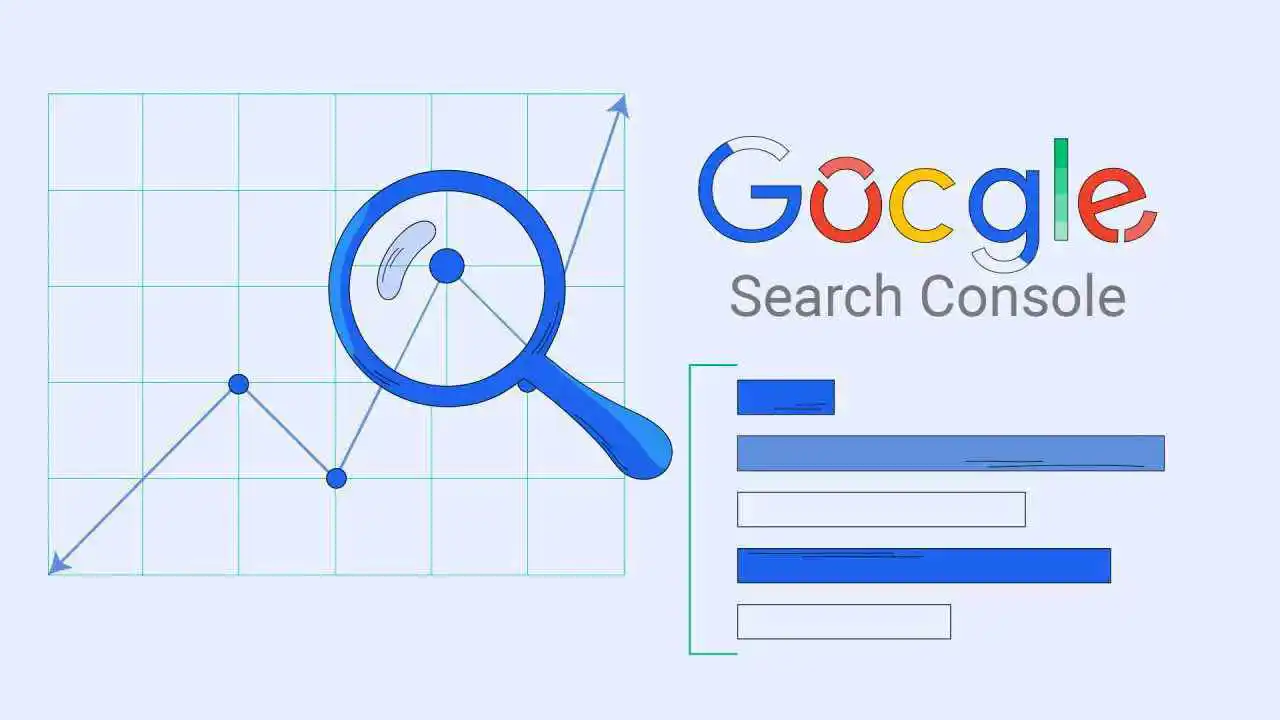
Table of Contents
In today’s digital marketing landscape, achieving search engine dominance is not just a goal but a necessity for brands aiming to stand out among the vast online competition. This is where Google Search Console (GSC) comes into play, serving as an indispensable tool for website owners, SEO professionals, and content marketers. GSC offers a comprehensive suite of utilities designed to monitor and report on your website’s presence in Google’s search results. By providing detailed insights into how Google views your site, GSC helps in identifying and fixing technical SEO issues, understanding your search traffic, and optimizing your content for better performance in search results.
GSC data for content marketing automation is a goldmine. It allows marketers to understand which parts of their content strategy are working and which need improvement. With GSC, you can access a wide range of information, including which queries bring users to your site, how your content performs in different regions, the devices your audience uses, and how effectively your site appears in search results. By analyzing this data, content marketers can refine their strategies, targeting the most valuable keywords and topics, optimizing for mobile and local search, and ultimately achieving greater visibility and engagement. This makes GSC an essential tool for anyone looking to leverage content marketing for SEO success, facilitating a smarter, data-driven approach to achieving search dominance.
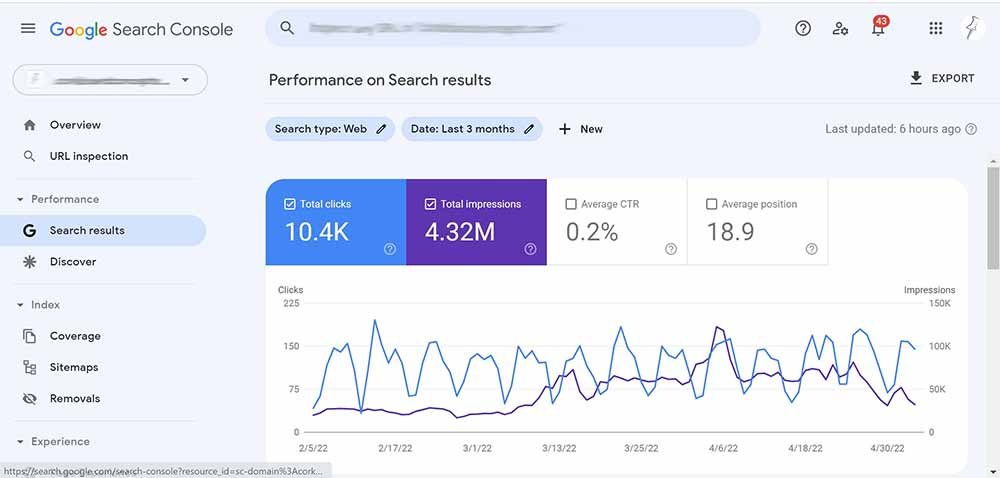
Google Search Console (GSC) offers a wealth of reports and tools designed to help website owners and digital marketers optimize their sites for better search engine visibility and user experience. Among these, the Performance Reports, Link Reports, and Indexing Reports are particularly valuable for devising effective content marketing and SEO strategies.
Performance Reports
The Performance Reports (like the one shown above) in GSC provide insights into how your website’s content performs in Google search results over time. These reports offer data on clicks, impressions, click-through rates (CTR), and the average position of your web pages for specific queries. This information is crucial for understanding which pieces of content are most visible to users and which ones are actually driving traffic to your site. By analyzing trends and patterns in this data, you can identify opportunities to improve your content’s ranking for specific keywords or topics, adjust your content strategy to focus on high-performing queries, and optimize existing content to boost its visibility and effectiveness.
Link Reports
Link Reports in GSC shed light on the external and internal links that point to your website. This section of GSC reveals who is linking to your site, which pages they’re linking to, and what anchor text they’re using. Understanding your site’s link profile can help you identify new partnership opportunities, gauge the impact of your link-building efforts, and detect potentially harmful links that could affect your site’s SEO health. Additionally, analyzing your internal link structure can help ensure that you’re effectively distributing page authority throughout your site and making it easier for search engines to crawl and index your content.
Indexing Reports
The Indexing Reports, known as the Coverage Report in GSC, offer critical insights into how well your site’s content is being indexed by Google. This report highlights any issues that might prevent Google from indexing your pages, such as crawl errors, server errors, or pages blocked by robots.txt. It also provides information on the number of pages that are successfully indexed. By monitoring and addressing the issues flagged in this report, you can improve your site’s overall SEO health, ensuring that all your valuable content is discoverable by Google and, by extension, by your target audience.
Together, these reports from Google Search Console provide a comprehensive overview of your website’s search performance, link ecosystem, and indexing status. By leveraging the insights gathered from these reports, marketers and SEO professionals can make informed decisions, prioritizing actions that drive traffic, improve search visibility, and enhance user engagement.
Turning data into actionable steps: Not so easy!
Turning the wealth of data from Google Search Console (GSC) reports into actionable insights for a content marketing plan indeed presents a significant challenge, especially for those without a background in SEO or a deep technical understanding of how search engines operate. The reports GSC provides are rich in detail, covering everything from search query performance to link analysis and indexing issues. However, deciphering this data to make informed decisions about content strategy, site structure, and SEO optimizations requires not just an understanding of what the data means but also how it interrelates and can be leveraged to drive better search performance.
For individuals and businesses without SEO expertise, the breadth and complexity of information can be overwhelming. It’s not just about seeing which pages have the most clicks or which keywords are driving impressions. It’s about understanding the user intent behind those searches, how different types of links (internal vs. external) contribute to your site’s authority, and identifying the technical barriers that might be preventing your content from being indexed or ranked favorably by Google. Additionally, interpreting trends over time, recognizing the impact of algorithm updates, and knowing how to respond to these changes are crucial skills that require both SEO knowledge and experience.
Moreover, SEO and content marketing are not static disciplines; they evolve continuously as search engines update their algorithms and as user behavior changes. This means that what worked yesterday might not work today, and staying ahead of these trends without a solid SEO foundation can be difficult. For businesses lacking this expertise, the challenge isn’t just in interpreting GSC data but in translating these insights into a coherent, adaptable content marketing strategy that aligns with their goals and audience needs.
In this context, many turn to SEO professionals or invest in training to bridge the knowledge gap. Others may seek out simplified tools and platforms that can interpret GSC data and recommend actions in more understandable terms. Regardless of the approach, the goal remains the same: to demystify the complexities of SEO and make the power of GSC accessible for content marketing success. Without this understanding, the risk is not just in misinterpreting the data but in potentially making decisions that could hinder rather than help a website’s search performance and visibility.
GSC Data for Content Marketing Automation: Media Monk’s Game Changing Approach
As an all-in-one content planning, marketing and distribution platform, Media Monk is on a mission to democratize content marketing for businesses of all sizes. It begins with helping entrepreneurs understand what is working, where the opportunities are, and how to adapt to the search algorithms.
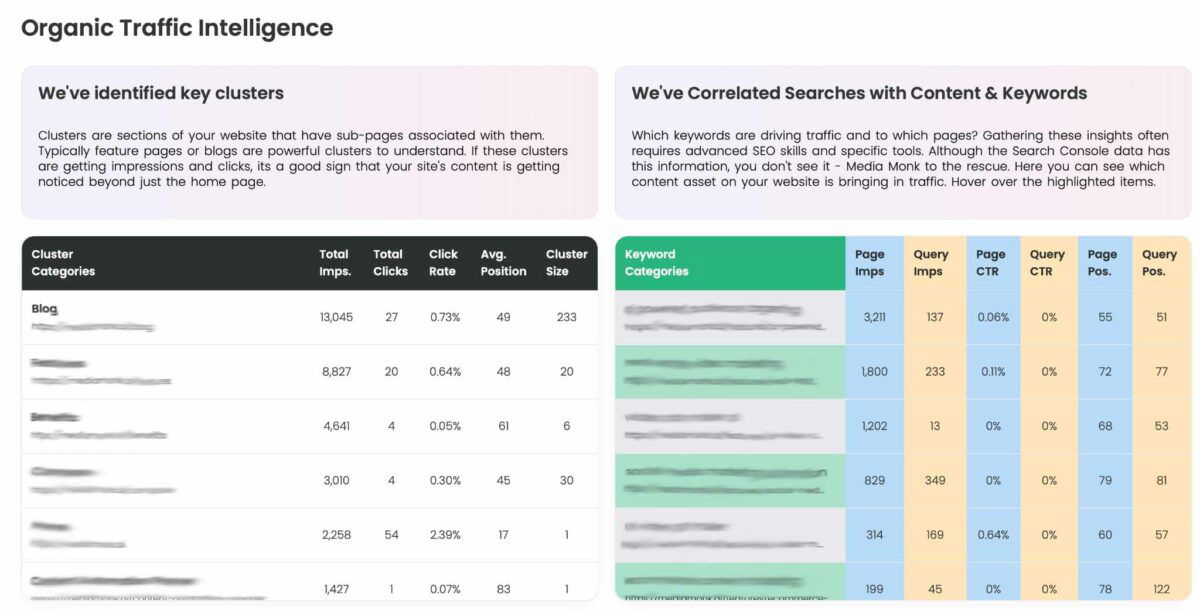
In the ever-evolving landscape of digital marketing, staying ahead means leveraging every tool at your disposal to ensure your content not only reaches your audience but also engages and converts. Media Monk’s latest feature release is a game-changer for content marketers, SEO strategists, and website owners alike: an advanced Content Marketing, Planning, and Automation platform equipped with an Organic Traffic Intelligence tool that does more than just analyze data – it translates it into strategic action.
Introducing Organic Traffic Intelligence
Media Monk’s Organic Traffic Intelligence tool transforms raw Google Search Console data into a powerhouse of actionable insights. It identifies key content clusters – groups of related pages or articles on your website, like blogs or feature sections – and correlates their performance with specific search queries. This isn’t just about visibility; it’s about understanding the direct impact of your content on your search performance.
The Power of Clustering
Clustering allows you to see which parts of your site are drawing attention. Whether it’s a blog post series or a collection of feature articles, you’ll know precisely what’s driving traffic. This feature helps you pinpoint successful strategies and areas for expansion, ensuring your content is noticed beyond just the home page.
Correlated Searches: Content & Keywords in Harmony
What keywords are driving traffic to which pages? With Media Monk’s tool, you’ll see a side-by-side comparison of page performance and keyword success, informing you which content assets are your true MVPs in SERPs. This level of detail guides you on where to focus your content creation efforts, optimizing your site for both user experience and search engine rankings.
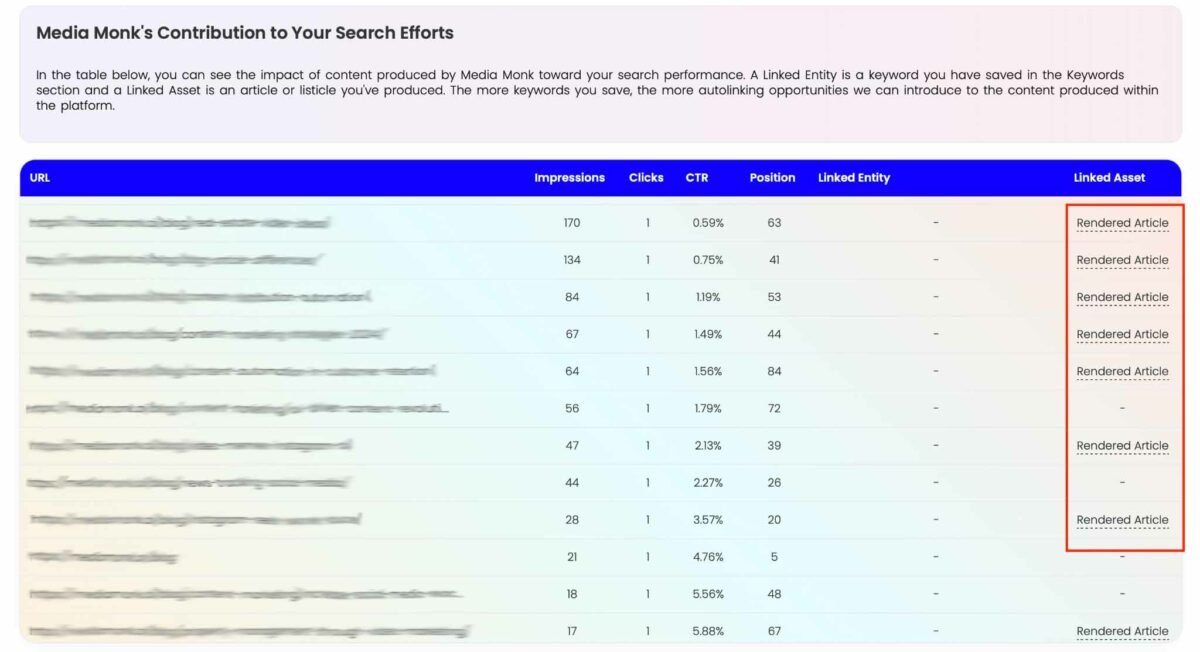
Media Monk’s Contribution to Your Search Efforts
Each piece of content you produce has a purpose, and now, you can measure it. Our tool attributes search appearances to content created within Media Monk, allowing you to see the direct results of your content strategy and adjust accordingly for maximum efficiency.
From Insight to Action
But it doesn’t end with analytics. This new feature lets you harness these insights practically. Select keywords directly from your data to create automated content plans. Generate long-form content with tailored focus and LSI keywords to amplify your site’s presence in search results and add depth to your site’s authority.
Benefits at Your Fingertips:
- Clarity: Understand exactly what content is performing and why.
- Strategy: Create content plans based on data, not guesswork.
- Automation: Use intelligent automation to produce content that resonates.
- Growth: Enhance your site’s E-A-T and SEO rankings systematically.
- Time-saving: Spend less time analyzing and more time creating.
Impressions for a Query Vs Impressions for a Page
In the context of Google Search Console (GSC), the difference between impressions for a query and impressions for a page revolves around what each metric represents in relation to user searches and your website’s visibility on Google Search.
Impressions for a Query
- Definition: The number of times any URL from your site appeared in search results viewed by a user for a specific query (search term). This does not mean the user clicked on your site; it merely indicates that a page from your site was shown in the search results for that particular query.
- Significance: Impressions for a query help you understand how often your site is shown for specific search terms. It’s a good indicator of the relevance and ranking potential of your content for those terms.
Impressions for a Page
- Definition: The number of times any specific URL (page) from your site appeared in search results viewed by a user, regardless of the query. This encompasses all appearances of that URL across various searches and does not require the user to have clicked on it.
- Significance: Impressions for a page give you insight into the overall visibility of that page in search results. It helps in identifying which pages on your site have the highest visibility in SERPs and can be used to gauge the effectiveness of your SEO strategies at the page level.
Key Differences
- Scope of Measurement:
- Query Impressions: Focused on how often your site appears for specific search terms.
- Page Impressions: Focused on the visibility of specific pages on your site across all searches.
- SEO Insights:
- Query Impressions: Useful for understanding the relevance and performance of your content for specific search terms. It’s crucial for keyword optimization and content strategy.
- Page Impressions: Useful for evaluating the overall visibility and reach of specific pages on your site. It helps in assessing the effectiveness of your on-page and off-page SEO efforts.
- Strategic Application:
- Query Impressions: Can inform content creation and optimization strategies by highlighting which queries are bringing users to your site.
- Page Impressions: Can inform technical SEO and site architecture decisions by showing which pages are most visible and potentially identifying issues with pages that should be performing better.
Understanding both metrics is vital for a comprehensive SEO strategy, as they provide different lenses through which to view and improve your site’s search performance.
GSC Data Discrepancies at Face Value
Sometimes you will notice that GSC data shows a particular query ranking your site higher than the page itself. But how would you explain the difference in the Query position of 52 (say) and Page position of 34?
Query-Specific Ranking: Google ranks pages based on the relevance and authority of the content for each specific query. The query “video ads maker ai” might have a wide range of competing content across the web, making it more competitive. The page from Media Monk might be well-optimized for related keywords but faces tougher competition or is deemed less relevant for this specific query, affecting its position.
User Intent and Content Match: Google aims to match search results with the user’s intent behind a query. If Google determines that the user intent behind “video ads maker ai” is informational, but the page is more transactional (or vice versa), it might not rank as highly for that query even if the page is closely related to the query terms.
Search Result Features: The presence of special search features (like featured snippets, video results, or knowledge panels) for certain queries can impact the visibility and perceived position of a URL in traditional search results. If “video ads maker ai” triggers such features more prominently, the page’s effective position in the eyes of users might be lower, despite a higher numerical rank.
Personalization and Localization: Search results are personalized based on factors like the user’s location, search history, and device. The average position reported in Google Search Console is an aggregate value. The page might rank higher in specific contexts (e.g., certain locations or devices) but lower in others, affecting its average position.
Differences in Search Volume and Competition: The query “video ads maker ai” may have different search volume and competition compared to other queries for which the page ranks. The page might rank better for less competitive or more niche queries, leading to a higher overall position when averaged across all queries.
Dynamic Search Algorithms: Google’s search algorithms are dynamic and continuously updated. A page’s position for a query can fluctuate based on changes in Google’s ranking factors, the appearance of new content on the web, or updates to the page itself.
It’s important to remember that the average position is just one metric among many to assess performance. A comprehensive SEO strategy should also consider factors like page relevance, content quality, user experience, and technical SEO to improve visibility across a range of related queries.
When Page Position is Better than Query Position
This is a unique metric that highlights the potential for a page on your site to rank higher and for more keywords if the content is expanded further or supported with other assets linking back to it. Let’s break down the key concepts involved in this analysis.
Semantic Relevance:
- Page Position > Query Position: If a page’s position is generally better than the specific query position, it may indicate that the page is deemed relevant by Google for a range of queries related to the topic, not just the specific one in question. This can indeed suggest a good level of semantic relevance of the page’s content for the broader topic area.
- However, it’s important to consider that search engine rankings are influenced by a multitude of factors, including backlink profiles, user engagement metrics, and the presence of rich content elements (images, videos, etc.). A better average position might reflect strengths in these areas in addition to semantic relevance.
- Food for thought: If your page is appearing for searches, and has a higher page position than the query position, but the position is greater than 20 (second page of Google SERPs), then see this as an opportunity to complement your content efforts with a backlink outreach plan for that particular page.
Potential for Ranking on LSI (Latent Semantic Indexing) Keywords:
- LSI Keywords: The concept revolves around the idea that Google and other search engines use related terms and concepts to better understand content on a webpage. If a page is ranking well for a set of semantically related keywords, it might indeed have the potential to rank for additional LSI keywords, given the depth and quality of its content.
- Subject Matter Authority: Ranking well across a range of semantically related queries can be a positive indicator of Google’s view of the page’s authority on the subject matter. It suggests that the content not only matches the search intent but also provides value that is recognized by both users and the algorithm.
- Food for thought: While LSI Keywords are not a direct ranking factor, they do help Google assign a broader subject matter expertise to your page. Meaning: If you are appearing for several LSI keywords, even though the rank is not high, it is contributing to your ‘Authority’ on the subject.
A Caution on Generalization:
- Too General a View? Yes, it can be too general or simplistic to assume that a better average page position always indicates higher semantic relevance or potential for ranking on related LSI keywords. Rankings are dynamic and context-dependent, influenced by ongoing competition, algorithm updates, and evolving user behavior.
- Comprehensive Strategy: A better approach is to use a comprehensive strategy that includes regular content updates, optimization for user experience, engagement metric analysis, and targeted efforts to improve authority on specific topics. Monitoring keyword performance over time, along with other SEO metrics, can provide more nuanced insights into how well a page is perceived for its relevance and authority.
In summary, while a good page position relative to specific query positions can be a positive sign, it’s essential to look at the bigger picture, including other SEO metrics and ongoing optimization efforts, to truly understand and enhance a page’s performance in search results.
Harnessing Semantic Relationships with Media Monk’s Advanced SEO Strategy

Deepen Your Content’s Impact: Diving into the world of Latent Semantic Indexing (LSI) keywords can significantly broaden the semantic reach of your website. By crafting additional blog content that targets these contextually relevant keywords, you’re painting a fuller picture of your site’s subject matter expertise.
Internal Linking: The SEO Super Glue: The strength of a page isn’t just in its standalone content but also in its connection to your site’s ecosystem. Strategic internal linking from newly created LSI-focused blog posts back to high-performing main pages isn’t just good housekeeping—it’s a potent SEO tactic that consolidates page authority and boosts ranking potential for an array of related searches.
Boost User Engagement: Well-architected internal linking is more than an SEO checklist item; it’s about fostering a seamless and enriching user experience. It guides visitors through a curated journey across your site, presenting them with valuable content at every turn.
Track, Learn, Optimize: Media Monk’s platform isn’t just about implementation—it’s also about ongoing learning and optimization. By keeping a close watch on how your SEO strategies are performing, you’ll glean insights that can refine and perfect your approach over time.
The Never-ending SEO Odyssey: SEO isn’t a static goalpost but a marathon with evolving milestones. The digital landscape is in constant flux, with search engines and competitors alike upping their game daily. Staying ahead means continually enhancing your site with quality content and revisiting existing pages for improvements.
Incorporating a strategy that embraces LSI keyword targeting and internal linking within Media Monk’s innovative platform marries data-driven insights with proven SEO methodologies. The result is a dynamic, living strategy that adapts to the ebbs and flows of search engine algorithms, ensuring your content doesn’t just exist but thrives and leads in the search results.
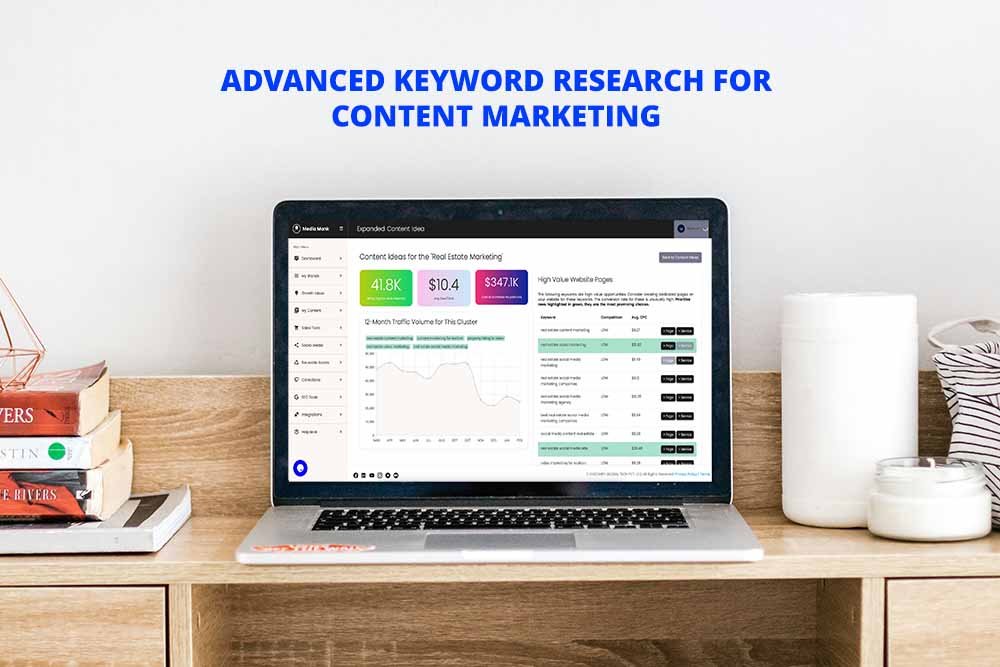
Discover how Media Monk’s AI-powered content marketing automation for SEO to revolutionize your online strategy and propel your rankings to new heights.


